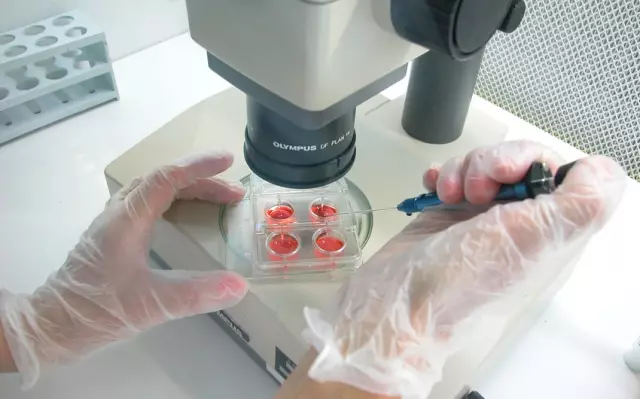- Author Rachel Wainwright [email protected].
- Public 2023-12-15 07:39.
- Last modified 2025-11-02 20:14.
How is atrial fibrillation treated?
The content of the article:
- What is atrial fibrillation
- Symptoms of atrial fibrillation
- Probable causes of atrial fibrillation
- Diagnostics
- How is atrial fibrillation treated?
- Potassium and magnesium deficiency in arrhythmia
- Replenishment of potassium and magnesium in atrial fibrillation
- Panangin for atrial fibrillation
Over the past decade, the incidence of diseases of the cardiovascular system has increased significantly. One of the most common diagnoses is atrial fibrillation. This type of arrhythmia is dangerous with complications, some of which are fatal. In order not to face the consequences, the disease must be treated on time. Let's talk in more detail about the symptoms, causes and treatment of cardiac arrhythmias.

What is atrial fibrillation
This pathological process is characterized by a violation of the heart rhythm, which is manifested by frequent, chaotic excitement and contraction of the atria or twitching, fibrillation of certain groups of atrial muscle fibers. This condition is extremely life-threatening for patients, as the pulse can reach 600 beats per minute. With a prolonged “attack”, the risk of stroke or blood clots increases significantly. According to statistics, this type of arrhythmia occurs quite often, in about 30% of cases. The pathological process has no age restrictions and can occur completely at any age, however, in persons over 50 years of age, this diagnosis is diagnosed much more often.
Please note that a prolonged paroxysm of atrial fibrillation (in other words, an attack) threatens with life-threatening complications. Thrombus formation and ischemic stroke are common complications. If signs of atrial fibrillation are found, an ambulance must be called immediately. While waiting for an ambulance, you need to take a horizontal body position.
Symptoms of atrial fibrillation
Symptoms of cardiac arrhythmia depend on the form of the pathological process, as well as on the individual characteristics of the human body. In most cases, atrial fibrillation is signaled by the following symptoms:
- A sharp increase in heart rate, which is felt as clear "jolts" in the chest.
- Lack of oxygen.
- Severe shortness of breath even with minimal physical exertion.
- The patient is worried about weakness and dizziness.
- Increased sweating.
- Often, against the background of atrial fibrillation, panic attacks, anxiety and fear occur.
- Tremor of the limbs.
- Muscle weakness.
- If the pulse is exceeded for 600 beats per minute, fainting is possible.
In most cases, atrial fibrillation bothers with attacks, their frequency and duration are individual. Please note that patients can feel atrial fibrillation in different ways: some feel extremely unsatisfactory, others do not even notice that the pulse is rapid and this is a very dangerous diagnosis, as a rule, in this case, the diagnosis is detected by chance during a planned ECG.
Probable causes of atrial fibrillation
Atrial fibrillation can be triggered by various factors. According to official statistics, the most common causes are concomitant diseases and abnormalities in the work of the cardiovascular system, for example:
- Age> 60 years
- Arterial hypertension
- Diabetes
- Cardiac ischemia
- Heart failure
- Extrasystole
- Chronic lung disease
- Obstructive sleep apnea syndrome
- Congenital heart defects
- Wolff-Parkinson-White syndrome (caused by a congenital anomaly of the myocardial conduction system)
You can also identify a number of indirect reasons that can lead to the development of atrial fibrillation:
- Excessive and regular consumption of alcoholic beverages
- Long experience of smoking
- Thyroid dysfunction
- Constant stress and nervous strain
- Uncontrolled intake of certain groups of medications (for example, psychostimulating drugs)
- Deficiency of potassium or magnesium in the body
Only a doctor can find out the exact reason why this disease arose. As soon as the first signs of atrial fibrillation appear, you should immediately consult a doctor!

Diagnostics
The diagnosis of atrial fibrillation is not difficult. As a rule, already during a physical examination, the doctor can detect something amiss: a too frequent, irregular pulse. For the final confirmation of the diagnosis, instrumental diagnostic methods are used, for example, electrocardiography. In order to identify the frequency and duration of attacks of atrial fibrillation, daily monitoring is prescribed. Additionally, a transesophageal examination of the heart can be performed.
Treatment of atrial fibrillation, the symptoms of which are extremely dangerous to human life, is prescribed only by a cardiologist, in no case do not self-medicate!
How is atrial fibrillation treated?
Treatment of atrial fibrillation should be started as soon as the diagnosis is finally confirmed. The specific therapy depends on the form of the disease, the degree of its severity and the individual characteristics of the organism. The first priority is to restore the heart rate and normalize the heart rate. Usually, treatment consists of taking new generation beta-blockers, anticoagulants, calcium channel blockers, antiarrhythmic drugs. Depending on the cause of atrial fibrillation, other groups of medications may be prescribed, for example, blood thinners.
In the event that drug therapy does not lead to positive dynamics, the patient may be offered surgical intervention. With atrial fibrillation, a minimally invasive operation is often performed - radiofrequency ablation. Also, with this type of heart rhythm disorder, a pacemaker can be installed.
In the treatment and symptoms of atrial fibrillation, one of the most important tasks is to restore the electrolyte balance, during which the patient's body is saturated with potassium and magnesium. Potassium and magnesium are two essential trace minerals for the smooth functioning of the heart. A deficiency of these two trace elements may well be the cause of the development of heart rhythm disturbances.
Potassium and magnesium deficiency in arrhythmia
Sometimes the cause of atrial fibrillation lies in the lack of vital trace elements in our body, especially potassium and magnesium. These two essential trace minerals help strengthen the heart muscle and support our heart. In addition, these substances significantly reduce the risk of complications. They help to normalize cholesterol levels in the body and blood pressure. The maximum assimilation of these trace elements is achieved with the simultaneous intake of potassium and magnesium, so doctors recommend choosing combination preparations containing both trace elements.
Potassium and magnesium deficiencies are common. It is due to the fact that even with proper nutrition, our body is able to assimilate no more than 35% of trace elements from the daily requirement. It is for this reason that a lack of potassium and magnesium is observed even in healthy people. The situation is much worse in people who suffer from arrhythmias and other types of heart rhythm disturbances. Some drugs for "heart" (for example, diuretics or diuretics) actively flush potassium and magnesium from the body, the lack of these trace elements leads to an increased risk of side effects from taking medications.
To find out that a person has an electrolyte deficiency, a specialized blood test is required. Unfortunately, in clinical practice it is often not done, so the lack of essential elements for the work of our heart remains unrecognized.
Replenishment of potassium and magnesium in atrial fibrillation
To eliminate the deficiency of potassium and magnesium, experts recommend revising the diet and including foods that contain potassium and magnesium. This measure is rather relevant for preventive purposes, for those who have not yet faced various diseases of the heart and blood vessels. Patients suffering from atrial fibrillation are recommended to take medications that contain a sufficient amount of potassium and magnesium.
Today, the pharmacological market offers various preparations containing these microelements, but an important point should be taken into account when choosing a remedy. The drug must contain at once two essential trace elements - potassium and magnesium. Only under this condition will electrolytes be fully absorbed by the body. Drinking either potassium or magnesium alone is useless, since a deficiency in one is often accompanied by a deficiency in the other.
It is also very important that potassium and magnesium are well absorbed. To do this, drugs use "conductors" of potassium and magnesium in the form of various salts that increase their bioavailability. It is best known for its effectiveness as potassium and magnesium aspartate.
It is he who is contained in the drug Panangin, which is popular both among patients and among doctors.

Panangin for atrial fibrillation
Most often, patients with atrial fibrillation are prescribed Panangin. This product contains potassium and magnesium in the form of asparaginates in an easily available form for assimilation. The drug, saturated with potassium and magnesium, helps to normalize the heart rate, additionally normalizes blood pressure, nourishes the heart muscle and improves the elasticity of blood vessels. In addition, Panangin is an excellent prevention of heart attack and stroke.
Please note that Panangin is part of the complex treatment of arrhythmia, it is prescribed simultaneously with other groups of medicines (beta-blockers, antiarrhythmic drugs, calcium channel blockers, etc.). The course of therapy is prescribed individually, depending on the severity of the pathological process and the individual characteristics of the organism. As a rule, the duration of therapy is at least 1 month.
The preparation of potassium and magnesium is vital for every “core”. Panangin helps keep the heart running smoothly and reduces the risk of developing cardiovascular disease.
Found a mistake in the text? Select it and press Ctrl + Enter.






